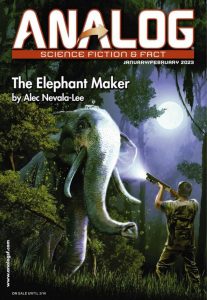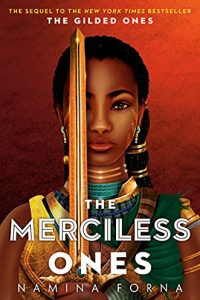Karen Burnham Reviews Short Fiction: Analog and Clarkesworld
 Analog 1-2/23
Analog 1-2/23
Clarkesworld 1/23
I started my 2023 reading year with Analog, always a stalwart. My favorite story of the issue is “EDIE”, a novelette by James Dick. EDIE is a robotic mission to Europa which we get to experience through the perspective of mission director Dr. Wendy Sloan. When the lander touches down successfully, there is much rejoicing in Houston. (The one big thing that threatened to kick me out of the story was that the mission was being controlled from the manned spaceflight center at NASA JSC. Usually robotic exploration missions are run from either JPL on the West Coast or APL on the East Coast.) A submersible is quickly deployed and almost as quickly lost when an ice-quake severs its umbilical. There’s a strange ice formation growing quietly nearby, something that doesn’t appear to be the result of natural processes. Through it all we get Wendy, her staff, and her daughter Kate bouncing ideas around trying to hypothesize about what’s happening millions of miles away, winding up with an opening of horizons. It’s a fun and quintessentially Analog story.
Reminding us that science doesn’t always work the way it’s supposed to, “Misplaced” by Shane Tourtellotte features a couple of miners way out in the Kuiper Belt. They find an asteroid out there with composition clearly similar to inner-system asteroid belt objects, but with an orbit that suggests it couldn’t have swung outward from there. At the risk to their own claim, clan, and profits, they put together a report and send it in-system to alert the science community to this potential outlier that may challenge some theories of solar system formation. They are by turns ignored, shunned, and accused of fraud. Even interested scientists are bullied away from engaging with them. They finally decide to tackle the research themselves, and I like that the ending zooms ahead and gives us a glimpse of how it turns out.
Another genre classic is the SF mystery, and the novelette “Hothouse Orchids” by Harry Lang fits the bill nicely. Mars has been colonized by SpaceX, but not all the second generation Martians are happy about being stuck there. Hector Kovack is a detective called to investigate the first-ever murder on Mars, with a victim tortured and buried outside. The plot takes him through anti-Martian resistance cells, an underground boxing gym, family drama, and people being replaced by cognizant avatars so good that no one knows they’re gone. The scene descriptions get a little heavy-handed, but I feel like it’s the noir influence bleeding through. The AI vs. people trope also features in Rajan Khanna’s tense novelette “The Bends”. It’s narrated by an AI that has been named Syd by its owner, Dolf. It’s an AI integrated into a scuba diving system that keeps track of the air/buoyancy/time spent variables so that the human diver can spend more time enjoying the experience. It also helps direct Dolf to things that will be interesting to him and identifies species that swim by. It becomes very concerned by Dolf’s increasingly unethical behavior and starts to nudge him in different directions. The story ramps up the tension smoothly to a quite dramatic climax. A much shorter but almost equally tense story is “A Real Snow Day” by M. Bennardo. Lyria and Kenton are in a cozy house with Lyria asking to just stay in and enjoy a snow day. But the illusion is somewhat broken when their neighbors drop by in rather anachronistic attire, and a brief power outage destroys the illusion completely. The reality of the situation is much more fraught than the cozy cottage scenario suggests, and it’s no wonder that Lyria much prefers the fantasy. There’s also a charming story, “Direct Message” by Tom Pike, that reminds us that not all SF has to be deadly serious. In this story, narrator Tom follows a really quirky Twitter account that starts to seem like it’s aliens learning to interact with humans on social media. The account eventually runs a poll about which area of Earth to wipe off the map and Appalachia, where Tom lives, is the “winner.” Of course these are real aliens with real destructive power, and Tom is left negotiating with them via DMs. He arrives at a clever solution and in the meantime delivers a robust defense of one of the more down-and-out, put-upon, and joked-about regions of the United States.
Clarkesworld has been great at featuring translated stories from China, and “Zhuangzi’s Dream” by Cao Baiyu (translated by Stella Jiayue Zhu) is a standout. It’s a beautifully told series of five vignettes, dreams the great sage Zhuangzi has long before he becomes famous. There’s K’un rising from the sea, worlds at war on the left and right tentacles of a snail, cosmic intelligences, artificial animals and people, and the antics of a time traveler observing the sleeping sage through a butterfly. There’s a vertiginous and Stapledonian aspect to the stories as they veer between scopes and scales, from the tiny slug to the vast cosmos. I hate to group two stories just on the basis of their both containing animals from the mollusca phylum (although that taxonomic grouping is probably somewhat over represented in speculative fiction), but I can’t help but turn next to “Pearl” by Felix Rose Kawitzky. Lux works at the Vera Rubin-inspired Large Observatory for the UnObservable Universe (LOUOU) They are frequently bored and start playing around with gengineering slugs for their garden. When called upon to deliver tea to the “real” scientists up in the collector area, Lux sometimes also brings the slugs along for some cosmic exposure. It’s a lovely contrast of the sublime and the ridiculous as the slugs start to metamorphose into something more esoteric than any of the characters might have expected.
The strangest story in this issue for me, though, is “Anais Gets a Turn” by R.T. Ester. After a complete meltdown of her career, Anais gets sucked into a group that is convinced that there is a world-spanning consciousness (which they nickname Waldo) and that it is playing tic-tac-toe with itself – always to a draw. So when Anais’s super important marketing meeting was completely disrupted by one of the director’s kids suggesting an ouroboros O-shaped logo in stead of Anais’s design, that was Waldo playing an O on its idea of a grid. The group gets to the point where they can predict what and where the moves will go, and they’re on a mission to make Waldo actually win a game, with the hope that it will move on to do something less disruptive to human life (some moves involve things like crashing trains at crossings to make an X, that sort of thing). So Anais and Rashad are on a cruise, hoping to prevent one man from getting a crossed anchor tattoo. The ship ends up stranded as Waldo forces it into position, and Anais has to explain herself to a skeptical but open-minded tattoo artist. The story becomes as much about Anais’s personal crisis as the struggle with Waldo, but both threads seem to pay off.
“Symbiosis” is a contribution from Clarkesworld regular D.A. Xiaolin Spires. It starts off as the story of the narrator who has been chosen as a Carrier. It is supposed to be an honor but they are at best ambivalent about it. Going through the stages of a kind of pregnancy, none of their experience matches that of other Carriers in their cohort. At first resistant to any acknowledgement of what they carry, they eventually strongly bond with their Package and in fact try to escape in order to keep it. Spires deftly moves us through the story, starting from a strange but typical genre trope (forced pregnancy for social/civic reasons) to an even stranger place. There’s a lot of body horror here centered on the pregnancy experience and those who experience it in different ways.
Recommended Stories
“Zhuangzi’s Dream”, Cao Baiyu (Clarkesworld 1/23)
“EDIE”, James Dick (Analog 1-2/23)
“Anais Gets a Turn”, R.T. Ester (Clarkesworld 1/23)
“The Bends”, Rajan Khanna (Analog 1-2/23)
Karen Burnham is an electromagnetics engineer by way of vocation, and a book reviewer/critic by way of avocation. She has worked on NASA projects including the Dream Chaser spacecraft and currently works in the automotive industry in Michigan. She has reviewed for venues such as Locus Magazine, NYRSF, Strange Horizons, SFSignal.com, and Cascadia Subduction Zone. She has produced podcasts for Locusmag.com and SFSignal.com, especially SF Crossing the Gulf with Karen Lord. Her book on Greg Egan came out from University of Illinois Press in 2014, and she has twice been nominated in the Best Non-Fiction category of the British SF Awards.
This review and more like it in the March 2023 issue of Locus.
 While you are here, please take a moment to support Locus with a one-time or recurring donation. We rely on reader donations to keep the magazine and site going, and would like to keep the site paywall free, but WE NEED YOUR FINANCIAL SUPPORT to continue quality coverage of the science fiction and fantasy field.
While you are here, please take a moment to support Locus with a one-time or recurring donation. We rely on reader donations to keep the magazine and site going, and would like to keep the site paywall free, but WE NEED YOUR FINANCIAL SUPPORT to continue quality coverage of the science fiction and fantasy field.
©Locus Magazine. Copyrighted material may not be republished without permission of LSFF.






